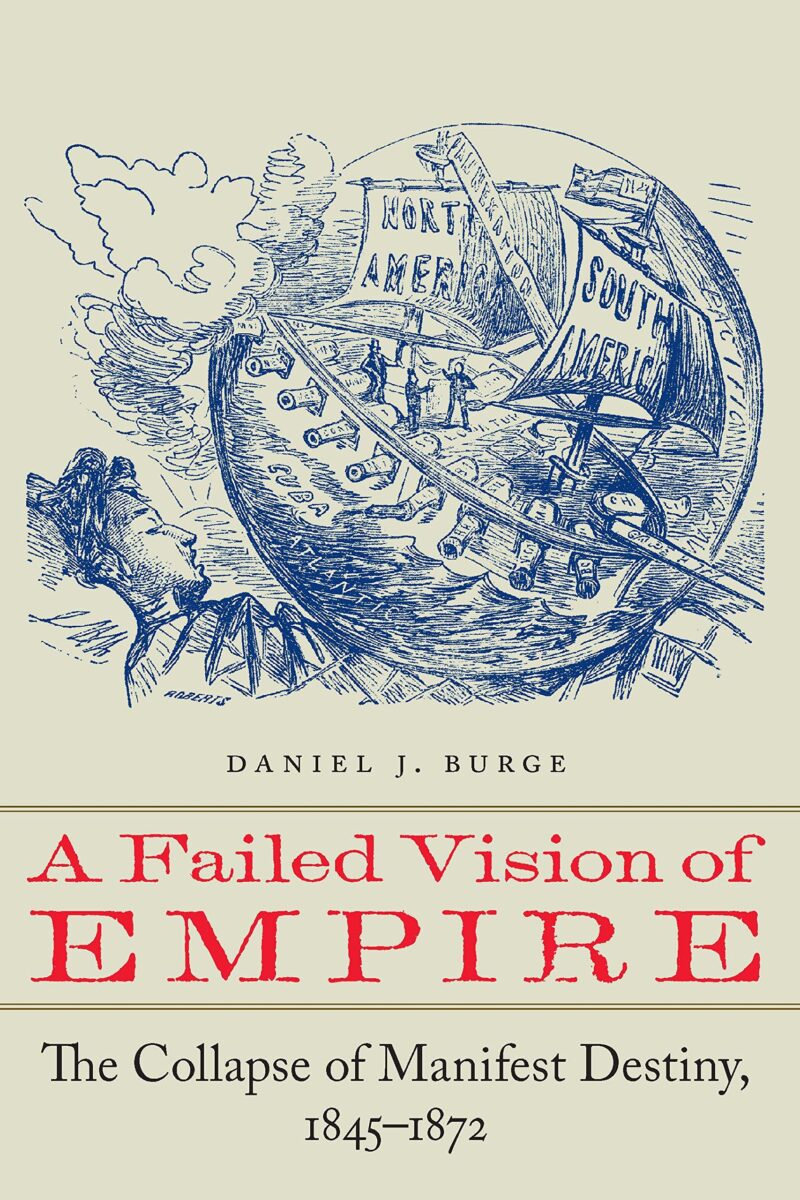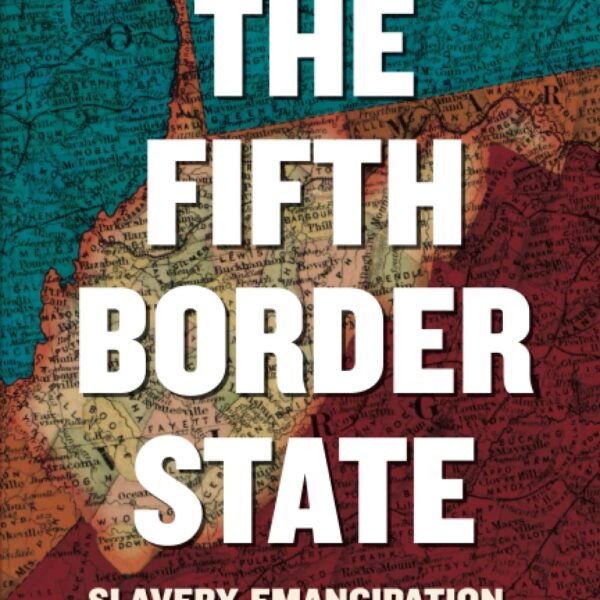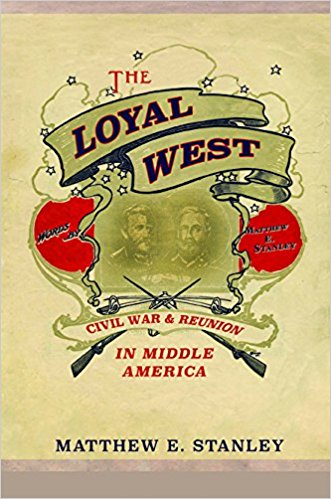In 1870, an article in the Louisville Courier-Journal provided an overview of the history of manifest destiny.[1] Orators, the author commented, used to speak “earnestly of the ‘manifest destiny’ of our Republic to enfold the whole continent” and were “sincere in their belief that under our then noble and benign system of government, State after State, and province after province, could be added safely…until ‘the whole boundless continent should be ours” (1). A Failed Vision of Empire uses this article to introduce its two main arguments about manifest destiny. First, Daniel J. Burge argues, the definition of manifest destiny has evolved considerably over time. Many people in the nineteenth century U.S.—such as the author of the article in the Courier-Journal—defined manifest destiny as “the idea that the United States was destined to absorb the continent of North America, along with Cuba” (2). However, in the early twentieth century, historians began to redefine the term as the idea that the United States was destined to acquire the Pacific Coast. Consequently, “working through this revised understanding, academic historians portrayed manifest destiny as a popular ideology that peaked in the 1840s under James K. Polk” (3). Burge labels this reconceptualization the “myth of manifest destiny” (7). He contends, with considerable justice, that it inhibits our understanding of this period. For one, the term, as contemporaries defined it, was much broader than what many scholars have portrayed. Second, manifest destiny neither peaked in the 1840s nor was it achieved. Rather, it remained incomplete. Thus, any study of this ideology requires a much broader period, hence the chronology Burge adopts that stretches into the 1870s. In sum, for people in the nineteenth century U.S., manifest destiny represented “the belief that the United States was destined to acquire the continent of North America, along with the island of Cuba” (16), not merely shorthand for westward expansion. This is an important argument, and it suggests scholars need to rethink how we understand and teach manifest destiny, emphasizing its continental—not just westward—dimensions.
The book’s second argument is linked to the first. Even taking the narrower “myth of manifest destiny” approach, scholars could and did point to people who never, for a plethora of reasons, accepted the ideology. But Burge offers a much wider vision of what manifest destiny meant to people at the time. Perhaps, then, it is logical that he has found a broad array of people opposed to the ideals of continental expansion manifest destiny offered. “The fact that Americans vigorously disagreed over manifest destiny,” he asserts, “illustrates that conflicting visions of empire emerged in the mid-nineteenth century” (17). Furthermore, “instead of seeing the middle of the nineteenth century as an era in which Americans shared a common vision of empire, we should view it as a time when multiple visions of empire clashed” (17). These are also important points although scholars have demonstrated the different types of empire and different imperial understandings that proliferated in the nineteenth century U.S. Furthermore, many scholars would not endorse the idea that people in the U.S. shared a common vision of empire. These points aside, what is particularly interesting here is how Burge’s argument changes the narrative of manifest destiny. Rather than seeing it as an ideology of westward expansion that succeeded under Polk, Burge illustrates manifest destiny’s relative weakness and how opponents skillfully drew on many different arguments to stymie expansion.
Over the course of seven chapters and an epilogue, Burge does an excellent job highlighting the various lines of argument opponents employed against manifest destiny. In 1846, Robert C. Winthrop delivered a speech on Oregon, in which he mentioned manifest destiny specifically to mock it. Winthrop was not alone in doing so, and Burge finds widespread opposition to manifest destiny during the U.S. War with Mexico. Opponents derided manifest destiny “as a blasphemous new religion and denounced proponents as false prophets” (23), claimed that it contradicted George Washington’s Farewell Address, sneered that it was a “robber’s doctrine” (24), and argued that it “would stir up sectional tension” (24). Southerners feared expansion would increase northern political power. Northerners feared expansion would facilitate the spread of slavery and empower slaveholders. Opponents derided the acquisition of desert. They also served up a racist critique about the dangers of adding Mexicans to the U.S. Thus, there was no singular line of opposition to manifest destiny. Opponents drew on whatever arguments struck them as strongest and most persuasive and these arguments “echoed well beyond the halls of Congress” (39). Although Polk wrested a considerable amount of territory from Mexico, manifest destiny did not truly win because opponents defeated attempts to acquire all of Mexico. The U.S. War with Mexico “should not be seen as the end of the era of manifest destiny, but rather as the first in a series of conflicts over the ideology” (44).
Opponents utilized the arguments they had forged during the U.S. War with Mexico repeatedly throughout the following decades to continue to oppose manifest destiny. In 1848, for example, Whigs sought to draw parallels between Zachary Taylor and George Washington. Although a general, Whigs painted Taylor as a man of peace and derided his opponent, Lewis Cass, as the war candidate. Whigs did not need to work particularly hard to make Cass, an ardent and full-throated expansionist, into the candidate of manifest destiny. Theirs was a multi-layered argument: vote for Taylor and peace, or Cass and war. Cass would provoke war precisely because of his embrace of manifest destiny, the robber’s doctrine. Taylor, who rejected the ideology, would not. Although Whigs differed in enthusiasm for Taylor, most of them “remained horrified at the thought of a believer in manifest destiny occupying the White House” (52). Taylor won the election and Secretary of State John Clayton negotiated the Clayton-Bulwer Treaty. This treaty drove a spear deep into the vitals of manifest destiny by proclaiming that the U.S. “would never colonize Central America” (60). Taylor did not try to hide the fact that this treaty contradicted manifest destiny.
Taylor’s election and the Clayton-Bulwer Treaty “shattered the dream of manifest destiny” (64), although the ideology was far from dead. Indeed, Zachary Taylor died in office and the Whigs lost the election of 1852. Democrats then controlled the presidency for eight years. Surely Franklin Pierce and James Buchanan could be counted on to advance the interests of manifest destiny? The reality was not so cut and dried. During Pierce’s presidency, opponents of manifest destiny revived the robber doctrine line of attack. This line of argument had faded after Taylor defeated Cass, but it proved useful against filibusters. Opponents benefitted from the fact that expansionists were of multiple minds. Some supported filibusters, where others considered them a hindrance to the cause of Cuban annexation. Unsurprisingly, opponents of manifest destiny adroitly exploited these divisions. Plans to acquire Cuba sputtered and, “in spite of retaking the White House, Democrats were unable to push forward manifest destiny” (66).
A new political context created new arguments against manifest destiny. Pierce’s presidency not only saw the revival of the robber doctrine line of attack, but it also led to the rise of a sectional critique of manifest destiny. Some Republicans and abolitionists began to argue that manifest destiny “was a southern ideology, created by enslavers to add territory” (88). This argument resonated with many of their contemporaries, especially in the aftermath of the passage of the Kansas-Nebraska Act. Pierce and Buchanan won the presidential elections in 1852 and 1856, but manifest destiny did not win. As Burge notes, “Buchanan’s Mexican gambit went nowhere” (102). Many Republicans vocally and effectively damned manifest destiny as the ideology of the enslavers and thwarted Buchanan’s expansionist goals. The sectional critique not only stymied Pierce and Buchanan, but it also helped Republicans win elections.
Lincoln’s election in 1860 ended Democratic control of the White House. However, Secretary of State William Henry Seward was one of the most ardent expansionists in the country. Seward embraced manifest destiny, but “believed that the United States could only add territory once the threat of slavery was removed” (110). Once the U.S. Civil War ended and slavery was abolished, Seward began to try to turn his dreams into reality. Critically, many Republicans did not share his vision. Consequently, manifest destiny remained a vibrant ideology and opponents had to develop new arguments; the sectional critique was no longer applicable. Instead, they crafted an environmental critique. They portrayed Alaska as a frozen tundra filled with icebergs and polar bears and the Danish West Indies as disease-ridden and plagued with earthquakes and volcanoes. Opponents could not defeat Seward’s purchase of Alaska, but they did derail the acquisition of the Danish West Indies. Seward, like Pierce and Buchanan, “left office having failed to bring about the fulfillment of manifest destiny” (130). The final chapter examines the Grant administration’s fervor for the annexation of Santo Domingo (the Dominican Republic). Here opponents employed a racial critique of manifest destiny. This was not a new argument; it had appeared during the U.S. War with Mexico and alongside the environmental critique of Alaska. Grant’s failure to get the treaty through the Senate “effectively ended the dream of manifest destiny” (152), although a few stubborn holdouts refused to abandon entirely the dream of manifest destiny.
“Although the myth of manifest destiny has simplified the story of expansion,” Burge remarks, “it has concealed the bitter disagreements that lay beneath the surface. It is only by jettisoning the myth of manifest destiny that we will be able to more fully understand the contingent and contested nature of U.S. empire” (22). Burge makes a forceful, and, in my opinion, persuasive, argument that scholars have long presented an inaccurate version of manifest destiny. To some extent, he overemphasizes the originality of his argument about the contested nature of U.S. empire. That having been said, this well-written, deeply researched, and provocative book deserves a wide readership because it advances important ideas that will spark plenty of discussions about manifest destiny and expansion in the nineteenth century U.S.
Evan C. Rothera is Assistant Professor of History at the University of Arkansas—Fort Smith.





